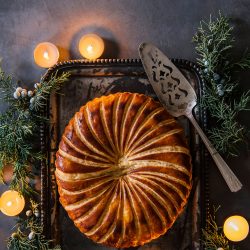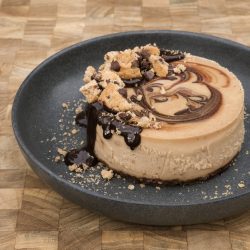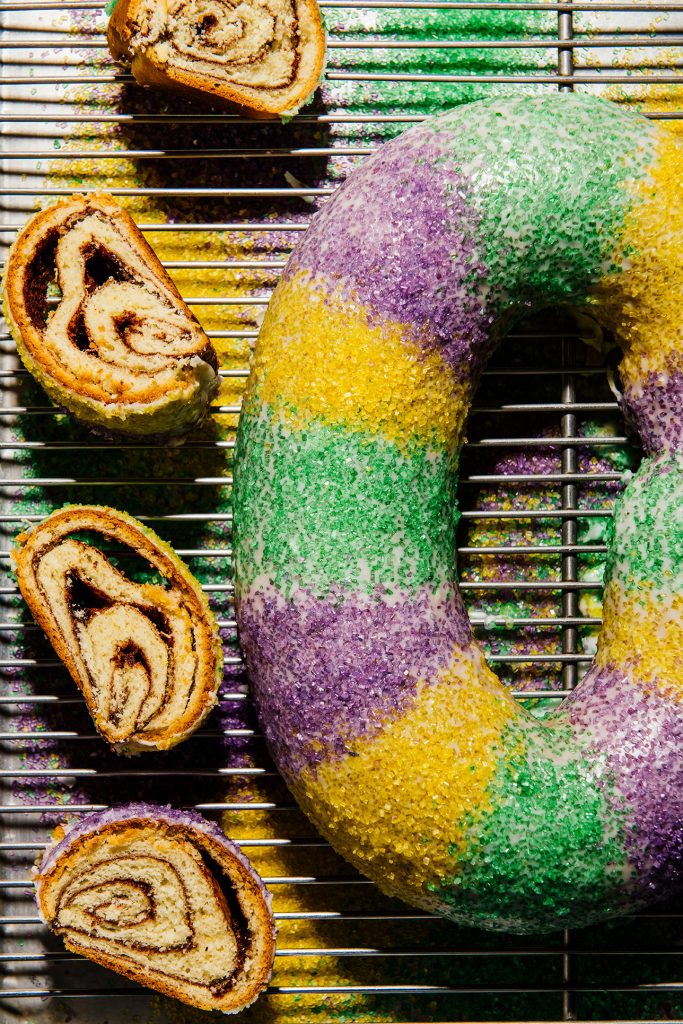
No Mardi Gras celebration would be complete without a festive, colorful New Orleans-style King Cake! The elegant French King Cake also joins the Fat Tuesday fun to close out the Carnival season, but the New Orleans-style of King Cake is probably the more recognized version in the United States.
Find the recipe for our take on New Orleans King Cake in our newest cookbook, Celebrate Every Day. Our version stays close to New Orleans tradition. It’s made with a tender, oval-shaped, yeasted sweet dough. It gets swirled with cinnamon sugar and then it’s baked to a golden brown. Finally, it’s decorated with white icing and three colors of sparkling sanding sugar. The Purple, Green, and Gold colors represent the official colors of Mardi Gras in New Orleans. As for the traditional trinket tucked inside, we’re old school. We opt for a whole almond, like in our French King Cake. Tradition has it that you’ll have good fortune if you find it in your slice!
Mardi Gras and New Orleans King Cake – Some History
In New Orleans, Carnival celebrations and King Cake go hand in hand. In early January around Epiphany, bakeries throughout the city start churning out King Cakes to kick off the Carnival season. This continues right up through Mardi Gras or Fat Tuesday. A local delicacy since the 1870s, the New Orleans King Cake is loaded with tradition. The yeasted sweet dough, spiced with cinnamon sugar, is rolled or braided. Then it’s smothered with thick white icing and lavishly dusted with three traditional colors of sanding sugar. The colors salute the city’s official colors of Mardi Gras: Green for faith, Purple for justice, and Gold for power.
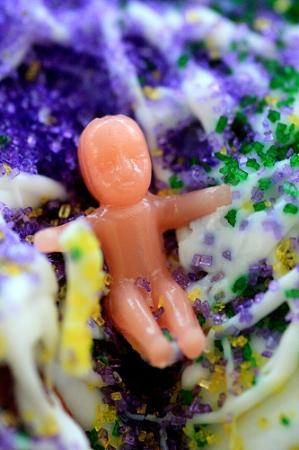
Also distinctive to the New Orleans King Cake is the small plastic baby trinket tucked into each cake. This modern tradition was popularized in the 1950s by McKenzie’s, the famed Uptown New Orleans bakery chain, since closed. The embedded trinket is a holdover from Medieval Spanish and French traditions. It has since become an essential part of Mardi Gras festivities, present and future. Tradition has it that the lucky person who gets the slice with the baby, in addition to being crowned King or Queen of the party or ball, will have good fortune and also must host the next year’s Mardi Gras celebration.
Much debate swirls around the symbolic meaning of the plastic baby trinket found in New Orleans King Cakes. Some swear it’s a religious nod to the baby Jesus, given the King Cake’s traditional ties to Epiphany, while others take a more secular stance. Donald Entringer Sr., the late owner of the famed McKenzie’s, proclaimed in a 1990 Carnival season interview with the city paper, The Times-Picayune, that “We were the first to use the babies. A salesman came in one day and said, ‘Look at this cute little thing. It won’t get lost like a pecan or a bean.’” Entringer went on to discount the notion that the baby was Jesus: “I’ve heard people say it’s supposed to represent the Christ Child, but that’s not true….Why we picked this, I don’t know. It was cute. It was just a trinket that happened to be a baby.”
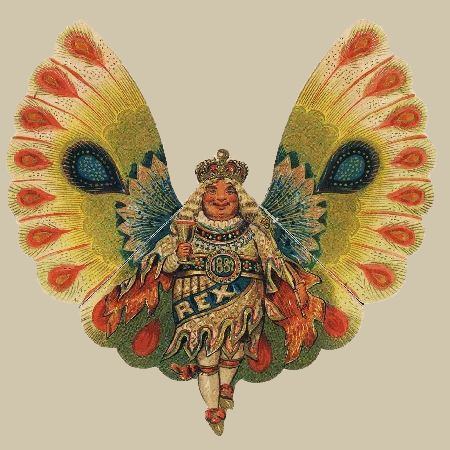
The lavish (and raucous) Mardi Gras celebrations are now a New Orleans institution and a worldwide tourist attraction. They came alive in 1872 with the founding of the Krewe of Rex, a.k.a. the King of Carnival and the Monarch of Merriment, when the city was still recovering from the Civil War. The mission of the Krewe was to entice tourists to visit the struggling city and businesses to put down roots in the community. Needless to say, they were extremely successful in their endeavors.
Since then, Rex, officially the School of Design, has held more parades on the city’s Uptown route on Mardi Gras Day than any other organization; and they are the origin of the official Carnival colors of purple, green, and gold (or yellow), among many other Mardi Gras traditions in New Orleans. Regardless of how it came to New Orleans, by the 1870s, the King Cake was firmly cemented in the city’s Twelfth Night and Carnival season revels.
Hungry for more?
- We’ve been known to do Spontaneous Bakes of our New Orleans King Cake to celebrate Fat Tuesday (2/13 this year). Follow us on Instagram to find out about these surprise offerings!
- Get the recipes for both our New Orleans and French King Cakes in our newest cookbook, Celebrate Every Day.
- Head to our blog for some history of French King Cake.
After a long, established career as a Ph.D. art history scholar and art museum curator, Lee, a Michigan native, came to the Bakehouse in 2017 eager to pursue her passion for artisanal baking and to apply her love of history, research, writing, and editing in a new exciting arena. Her first turn at the Bakehouse was as a day pastry baker. She then moved on to retail sales in the Bakeshop, followed by joining the Marketing Team and becoming the Bakehouse’s designated culinary historian. In addition to her retail sales and marketing work, she’s a member of the Bakehouse’s Grain Commission, co-author and editor of the Bakehouse's series of cookbooklets, and a regular contributor to the BAKE! Blog and Zingerman’s Newsletter, where she explores the culinary, cultural, and social history and evolution of the Bakehouse’s artisan baked goods.

